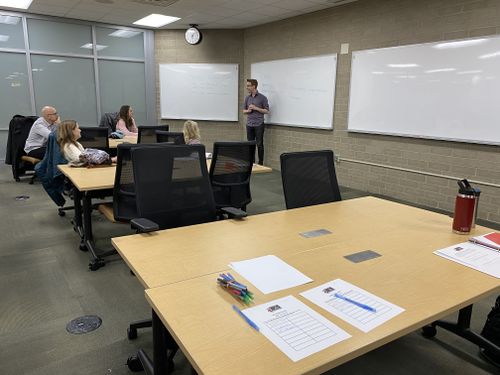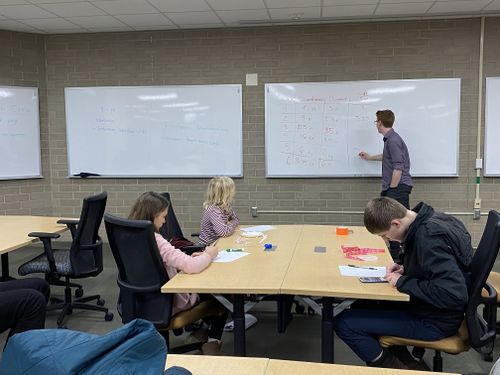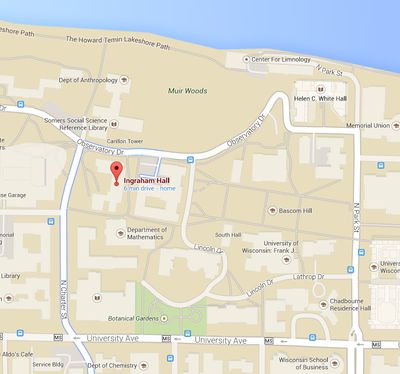Madison Math Circle: Difference between revisions
| Line 173: | Line 173: | ||
You have gotten a tip that a famous art thief is going to steal something from the Louvre. It is your task to organize a security team that can watch all the works of art. The problem is that the Louvre is really big and has a strange layout. Where do you put your guards? And how many do you need? | You have gotten a tip that a famous art thief is going to steal something from the Louvre. It is your task to organize a security team that can watch all the works of art. The problem is that the Louvre is really big and has a strange layout. Where do you put your guards? And how many do you need? | ||
===Eva Elduque=== | |||
"Pick's Theorem" | |||
In this talk, we will find a very easy formula that will allow us to quickly compute the areas of polygons whose vertices are on points of a grid, and we will prove that this formula works. | |||
Revision as of 13:13, 22 September 2015
LAST MINUTE LOCATION ANNOUNCEMENT
Due to a CONTINUED scheduling snafu, our SEPT 21 meeting will ALSO take place in B215 Van Vleck. This is on the 2nd basement floor of Van Vleck Hall, which is right next to Ingraham Hall. (On the map below it is the "Department of Mathematics Building".)
Weekly Meeting
We have a weekly meeting, Monday at 6pm in 120 Ingraham Hall, during the school year. New students are welcome at any point! There is no required registration, no fee, and the talks are independent of one another, so you can just show up any week. See below for directions.
If you are a student, we hope you will tell other interested students about these talks, and speak with your parents or with your teacher about organizing a car pool to the UW campus. If you are a parent or a teacher, we hope you'll tell your students about these talks and organize a car pool to the UW (all talks take place in Ingraham Hall room 120, on the UW-Madison campus).
What is a Math Circle?
The Madison Math Circle is a weekly series of mathematically based activities aimed at interested middle school and high school students. It is an outreach program organized by the UW Math Department. Our goal is to provide a taste of exciting ideas in math and science. In the past we've had talks about plasma and weather in outer space, video game graphics, and encryption. In the sessions, students (and parents) are often asked to explore problems on their own, with the presenter facilitating a discussion. The talks are independent of one another, so new students are welcome at any point.
The level of the audience varies quite widely, including a mix of middle school and high school students, and the speakers generally address this by considering subjects that will be interesting for a wide range of students.
After each talk we'll have pizza provided by the Mathematics Department, and students will have an opportunity to mingle and chat with the speaker and with other participants, to ask questions about some of the topics that have been discussed, and also about college, careers in science, etc.
The Madison Math circle was featured in Wisconsin State Journal: http://host.madison.com/wsj/news/local/education/local_schools/school-spotlight-madison-math-circle-gives-young-students-a-taste/article_77f5c042-0b3d-11e1-ba5f-001cc4c03286.html
All right, I want to come!
Directions and parking
Meetings are held in 120 Ingraham Hall.
Parking. Parking on campus is rather limited. Here is as list of some options:
- Directly in front of Ingraham hall, 2 metered spots (25 minute max) in Lot 11 off of Observatory Drive.
- A 0.2 mile walk to Ingraham Hall via these directions, many spots (free starting 4:30pm) in Lot 26 along Observatory Drive.
- A 0.3 mile walk to Ingraham Hall via these directions, many spots (free starting 4:30pm) in Lot 34.
- A 0.2 mile walk to Ingraham Hall via these directions, 2 metered spots (25 minute max) in front of Lathrop Hall.
- A 0.3 mile walk to Ingraham Hall via these directions 6 metered spots (25 minute max) around the loop in front of Chadbourne Hall .
- For more information, see the UW-Madison Parking Info website.
Email list
Sign up for our email list: https://lists.math.wisc.edu/listinfo/math-circle
Contact the organizers
If you have any questions, suggestions for topics, or so on, just email the organizers (Carolyn Abbott, Gheorghe Craciun, Daniel Erman, Lalit Jain, Ryan Julian, and Philip Matchett Wood): math-circle-organizers@math.wisc.edu. We are always interested in feedback!
Report on Math Circle in 2013-14
Donations
Please consider donating to the Madison Math Circle. As noted in our annual report, our main costs consist of pizza and occasional supplies for the speakers. Our costs have been covered so far by donations from the UW Math Department plus generous gifts from a private donor. But our costs are rising, primarily because this year we expect to hold more meetings than in any previous year. In fact, this year, we expect to spend at least $2500 on pizza and supplies alone.
So please consider donating to support your math circle! The easiest way to donate is to go to the link:
There are instructions on that page for donating to the Math Department. Be sure and add a Gift Note saying that the donation is intended for the "Madison Math Circle"! The money goes into the Mathematics Department Annual Fund and is routed through the University of Wisconsin Foundation, which is convenient for record-keeping, etc.
Alternately, you can bring a check to one of the Math Circle Meetings. If you write a check, be sure to make it payable to the "WFAA" and add the note "Math Circle Donation" on the check.
Or you can just pay in cash, and we'll give you a receipt.
Flyer
Please feel free to distribute our flyer! Flyer
Help us grow!
If you like Math Circle, please help us continue to grow! Students, parents, and teachers can help by:
- Posting our flyer at schools or anywhere that might have interested students
- Discussing the Math Circle with students, parents, teachers, administrators, and others
- Making an announcement about Math Circle at PTO meetings
- Donating to Math Circle
Contact the organizers if you have questions or your own ideas about how to help out.
Meetings for Fall 2015 and Spring 2016
All talks are at 6pm in Ingraham Hall room 120, unless otherwise noted.
| Fall 2015 | ||
|---|---|---|
| Date | Speaker | Topic |
| September 14, 2015 | David Sondak | How to SEE Sound |
| September 21, 2015 | Uri Andrews | Guarding Mona Lisa |
| September 28, 2015 | Eva Elduque | Pick's Theorem |
| October 5, 2015 | Jessica Lin | Abstract |
| October 12, 2015 | Ryan Julian | Abstract |
| October 19, 2015 | Keith Rush | Abstract |
| October 26, 2015 | Megan Maguire | Abstract |
| November 2, 2015 | Marko Budisic | Abstract |
| November 9, 2015 | Tess Anderson | Abstract |
| November 16, 2015 | DJ Bruce | Abstract |
| November 23, 2015 | Tullia Dymarz (Last meeting of fall) | Abstract |
| Spring 2016 | ||
| Date | Speaker | Topic |
| February 1, 2016 | Will Mitchell | Are these networks the same? |
| February 8, 2016 | TBA | Abstract |
| February 15, 2016 | Jordan Ellenberg | Abstract |
| February 22, 2016 | TBA | Abstract |
| February 29, 2016 | TBA | Abstract |
| March 7, 2016 | TBA | Abstract |
| March 14, 2016 | TBA | Abstract |
| March 21, 2016 | No Meeting (Spring Break) | Abstract |
| March 28, 2016 | No Meeting (Spring Break) | Abstract |
| April 4, 2016 | TBA | Abstract |
| April 11, 2016 | Andrew Kidd | Abstract |
| April 18, 2016 | TBA | Abstract |
| April 25, 2016 | TBA | Abstract |
| May 2, 2016 | TBA | Abstract |
High school meetings for Fall 2015
We are experimenting with holding some Math Circle meetings directly at local high schools. Our schedule for the fall is below. If you are interesting in having us come to your high school, please contact us!
| Fall 2015 | ||||
|---|---|---|---|---|
| Date | Location | Speaker | Topic | Link for more info |
| September 28, 2015 | 2:45pm East High | Daniel Erman | Abstract | |
| October 19, 2015 | 2:45pm East High | Uri Andrews | Abstract | |
Abstracts
David Sondak
How to SEE Sound
The idea is to give a simple overview of sound waves by introducing sines and cosines and some of their basic anatomy (amplitude and frequency). We will then have a computational component where the students create their own sound waves by fiddling with parameters in the sines and cosines (again, amplitude, frequency and different superpositions of the sines and cosines). They will actually be able to see plots of their waves AND listen to their waves. Finally, if time permits, the students will use their own sound waves to make Oobleck dance. This will bring the exercise full circle in that they will be able to see their very own sound waves in action.
Uri Andrews
"Guarding Mona Lisa"
You have gotten a tip that a famous art thief is going to steal something from the Louvre. It is your task to organize a security team that can watch all the works of art. The problem is that the Louvre is really big and has a strange layout. Where do you put your guards? And how many do you need?
Eva Elduque
"Pick's Theorem"
In this talk, we will find a very easy formula that will allow us to quickly compute the areas of polygons whose vertices are on points of a grid, and we will prove that this formula works.
Daniel Erman
"How to catch a (data) thief"
I will discuss some surprising statistical facts that have been used to catch companies that lie about data.
Will Mitchell
Are these networks the same?
The question of deciding whether two things are the same comes up in many different places in math. In this session we'll consider the problem of deciding if two networks or "graphs" are the same. This leads to some entertaining and challenging puzzles. We will also learn a bit about how people try to solve similar problems using computers. This problem has applications in the design of electronic circuits and in searching for organic chemical compounds within large databases.
Contact Information Form
Link to Contact Information Form
Archived Math Circle Material
Link for presenters (in progress)
https://www.math.wisc.edu/wiki/index.php/Math_Circle_Presentations


